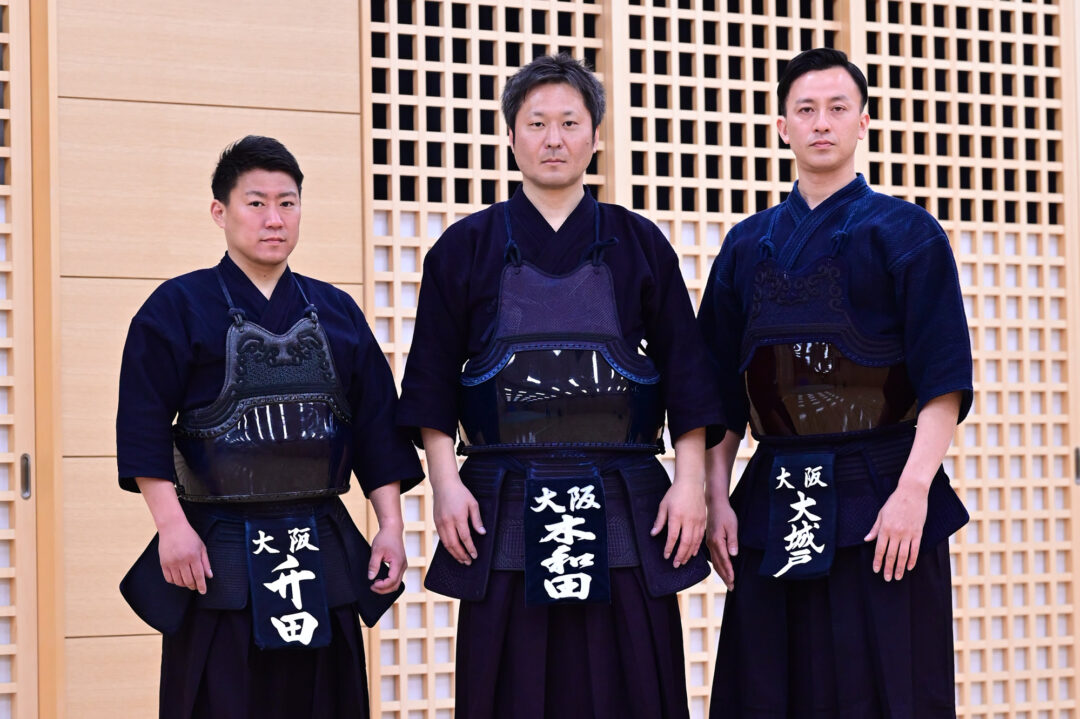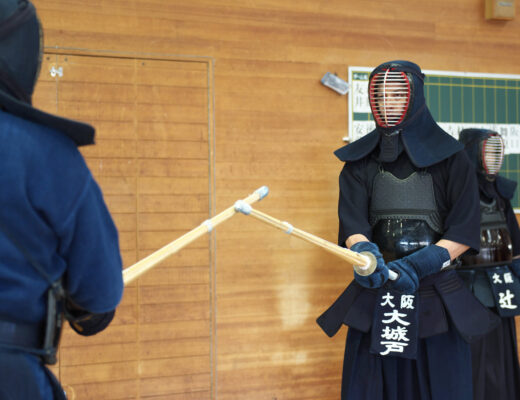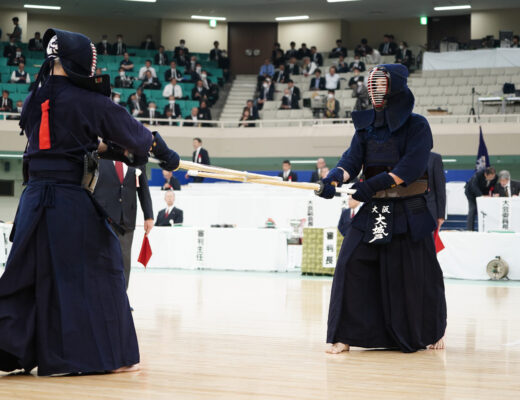KendoJIDAI 2023.6
Planning: Teraoka Tomoyuki
Photography: Nishiguchi Kunihiko
Translation: Jouke van der Woude
Kiwada Daiki, Okido Satoru, Masuda Ryo. These three individuals who have represented Japan and are key competitors for the Osaka Prefectural Police, discussed the importance of footwork and the ideal footwork that suits them best.
Kiwada Daiki
Born in 1978 in Mie Prefecture. He attended Mie High School and then enrolled in Chuo University. After graduating, he joined the Osaka Prefectural Police Department. Notable achievements include winning the All Japan Kendo Championships, the team title at the World Kendo Championship, the All Japan Police Individual Championship, and finishing third in the All Japan Invitational 7th Dan Championship. Currently, he serves as a Kendo instructor at the Sumiyoshi Police Station of the Osaka Prefectural Police.
Okido Satoru
Born in Ehime Prefecture in 1984. After graduating from Nitta High School, he went on to study at the National Institute of Fitness and Sports in Kanoya, and after graduating, he joined the Osaka Prefectural Police Department. Major achievements include participating in the All Japan Kendo Championship, winning the team title at the World Kendo Championship and the title of the All Japan Police Individual Championship. He currently serves as an instructor at Ikuno Police Station of the Osaka Prefectural Police.
Masuda Ryo
Born in Ehime Prefecture in 1985. He attended Nitta High School and then enrolled in Chuo University. After graduating, he joined the Osaka Prefectural Police Department. Notable achievements include participating in the All Japan Kendo Championships, winning the team title at the World Kendo Championship, and finishing third in the All Japan Police Individual Championship. Currently, he serves as a Kendo instructor at the Higashi Sumiyoshi Police Station of the Osaka Prefectural Police.
The catalyst for reevaluating footwork
—Please share your impressions of each other’s footwork.
Masuda: Looking back at when I first joined the Osaka Prefectural Police, neither Kiwada Sensei nor Okido Sensei gave me the initial impression of having proficient footwork. In fact, since the Osaka Prefectural Police tends to have larger athletes, there wasn’t much of an image of utilizing agile footwork in our overall Tokuren training.
Okido: That’s right. I had the same impression as Masuda Sensei at first. As I grew older, I began to realize that everyone started working on their footwork behind the scenes. Among them, the senior whose footwork I visibly admired the most at that time was that of Kiwada Sensei, without a doubt.
Kiwada: When thinking of the term Ashisabaki (footwork), the general image is that of someone who can perform quick Suriashi. If we only look at that aspect, we didn’t have particularly skillful footwork earlier on. It was towards the end of our active careers that we each developed footwork that suited us. Okido Sensei has a strong image of skillful Tsugiashi (successive footwork). He can smoothly transition from Kote to Men or from Men to Men, a unique technique that others can’t easily replicate. As for Masuda Sensei, my impression is that his ability to withstand attacks or counterattack with his left foot is impressive. Normally, when under attack, people tend to quickly step back and regain their posture, but Masuda Sensei lowers and braces his left foot, allowing him to launch techniques from there. I think it was his footwork that enabled him to compete against opponents with larger physiques.
—When did you start becoming aware of footwork?
Masuda: It was when I joined the Osaka Prefectural Police. I came here with some confidence, but once I started, I couldn’t keep up, and I sensed that it was a problem. I was being struck from a distance I had never been hit before, so I started thinking about how I could avoid getting struck, which led me to consider footwork.
Okido: When I was younger, I tried to think about using my feet more, but eventually, I realized that the key was to not overuse footwork. It was about using footwork in a way that the opponent wouldn’t notice. As I progressed in my career, I started thinking about footwork like that. And when I did, I found myself having more mental composure during Shiai, and I was able to have performances that I could be content with.
—Kiwada Sensei, it’s well known that you reevaluated your footwork after being eliminated in the World Kendo Championships, is that correct?
Masuda: I was around Kiwada Sensei after the WKC, and I often saw him practicing alone, focusing only on footwork at the dojo. After that, he went on to win the All Japan Championships.
Okido: I also had the opportunity to compete together with Kiwada Sensei in the World Kendo Championships in Italy, and the ability he gained to quickly turn around after returning to Japan was remarkable. Personally, I struggled with disappointing results in individual competitions, and it affected me for a while.
Kiwada: When I lost two Ippon to a South Korean competitor in the World Kendo Championships, I consulted with Takanabe Susumu about what went wrong. He told me, “Daiki, you’re not using your footwork. Because you don’t regularly focus on footwork in your Kendo, it becomes tough when you try to solely rely on defense.” Indeed, I thought I was using footwork to defend myself in the World Championships, but I ended up depleting my stamina and getting scored on twice in the final minute. That’s when I decided to strengthen my footwork for the upcoming All Japan Kendo Championships.
—What kind of training did you undertake?
Kiwada: The key was transitioning between defense and offense. It’s easy to just defend, but it’s difficult to connect defense with subsequent attacks. I focused on this aspect during Keiko.
Masuda: When I had Keiko with Kiwada Sensei, who had started focusing on footwork, I found that many of my attempted strikes didn’t reach him, which caused me to feel a lot of psychological pressure. That was the most dramatic change.
Kiwada: Shortly after I began training footwork, we had the district tournaments. I was able to successfully defend my lead there, and it gave me a sense of truly making the defensive footwork my own. Then I realized that before the national police tournaments and the All Japan Kendo Championship qualifiers, I had to turn this defensive footwork into footwork that could get Ippon, and that was challenging. It didn’t match up at all. I had to figure out the right stride to move without nullifying my techniques. It wasn’t until I was competing in the All Japan qualifiers that I finally felt a sense of harmony within myself.
—I see. Okido Sensei and Masuda Sensei, what kind of footwork did you start seeking in your training?
The rest of this article is only available for Kendo Jidai International subscribers!





